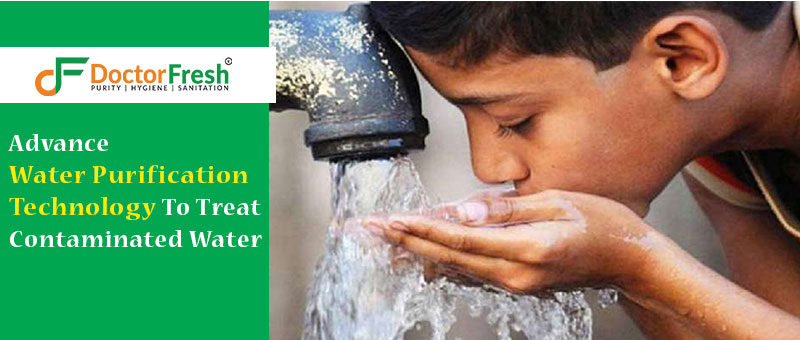Water is the basic need of all the living organisms living on the planet earth. It is because water helps in various functions of the body and maintains proper hydration inside the body. But, unfortunately, the water is getting polluted by various human and natural activities, and polluted water is unsafe for human consumption. Here in this blog, we will be discussing the various methods to purify water so let's get started.
Water purification is a process used to treat contaminated water to bring pure and healthy water irrespective of the source of water. There are various methods to achieve water purification, but technology plays an essential role in bringing pure and healthy water. So let's start discussing few innovative technologies that have shown a significant impact on water purification.
Here we have listed some of the best and advanced water purification technologies to eliminate contamination from water. These are
- Nanotechnology
- Acoustic Nanotube Technology
- Photocatalytic Water Purification Technology
- Aquaporin Inside Technology
#1. Nanotechnology
Nanotechnology-based water purification is considered modular, highly efficient, and cost-effective compared to the other conventional water purification methods. The large surface-to-volume ratio of nanotechnology improves the separation of chemicals and biological particles. Currently, nanotechnology is playing a vital role in water purification. Nanotechnology uses nano-membranes that separate the physical, chemical, and biological contaminants from the water, making water healthier for consumption.
According to the research, nanotechnology can eliminate contamination from the water. And Carbon nanotube, Nano-cellulose application, and Golden Nanoparticles have shown tremendous response. So let's discuss them one by one
Also Read- What Are The Needs Of Water Purification?
- Carbon Nanotube Application For Water Purification
Carbon nanotube application (CNT) is one of the most popular nanotechnology-based water purification methods. In 1991, a Japanese scientist discovered the carbon nanotube. In the water purification system, a used carbon nanotube allows the water molecules to pass through the tube's pores but traps the microbes to the carbon surface. Thus it prevents microbial and chemical hazards from entering purified water and makes it safe for human consumption.
- Nano-cellulose Application For Water Purification
A Nano-cellulose approach is similar to CNT in functionality but differs in the manufacturing process. In the technology, cellulose, Nano-crystals & Nano-fibrils (CNC & CNF) are used, which selectively absorb water contaminants from the water stream, thus making water consumable.
- Golden Nanoparticles For Water Purification
According to the study conducted by collective research groups, a scientist has found that gold nanoparticles help eliminate hazardous contaminants from the water. In this technology, Nano-rods are used, which could conduct heat in a localized fashion to destroy water pollutants like pharmaceutical waste, anti-pesticides with other hazardous substances. Golden nanoparticles eliminate water contaminants in a more effective way than heating the entire volume of water.
#2. Acoustic Nanotube Technology
NASA's Johnson Space Centre introduces acoustic nanotube technology. Acoustic nanotube technology is an acoustically driven nanotechnology molecule that is embedded with small-diameter carbon nanotubes. This prevents hazards from entering the purified water stream and makes water suitable for drinking.
The acoustic nanotube technology is better than other existing water purification technology that are low in productivity, consume comparatively high energy, and have higher costs. Acoustic nanotechnology is designed to mitigate these limitations. Thus, acoustic nanotube technology is an innovative way to bring pure and clean water for drinking purposes.
Acoustic nanotube technology works differently than then exiting water purification system as it pushed water away from the contaminant instead of eliminating contaminant from the water; in this technology, when water enters the system first contacts the filter matrix, which is made upon polymer, ceramic, or metallic compounds, depending upon the end-use requirements.
#3. Photo Catalyst Water Purification Technology
Photocatalyst is one of the modern and advanced water purification technologies discovered by Panasonic. This technology detoxifies the contaminated water at a higher speed and brings healthy water for consumption. This water purification system uses photocatalysts and UV rays for creating clean water.
When the photocatalysts are exposed to the UV rays, they release reactive oxygen that purifies the water from toxic water pollutants. Apart from being the light-driven water purification technology, a photocatalysts water purification system eliminates the adverse effects of pharmaceutical waste. Along with this, a Photocatalysts purification system offers a low-cost and environmentally friendly way of treating water.
A photo-catalyst water purification possess various advantages, which are
- Influential In Decomposing Water Pollutant- Due to the powerful oxidant ability of "HO '', the organic pollutant present in the water can easily decompose and even mineralize. This technology can be used widely when advanced treatment of water is demanded
- Ambient Operating Conditions- The process occurs under ambient operating conditions; thus, a photocatalyst is considered relatively safe
- Low In Cost- The entire process is based on the sunlight and the ambient O2. The photocatalyst (TiO2) can be recycled; thus, the complete process is cost-effective
- Environmentally Friendly- The TiO2 is non-toxic, chemically stable, and less or nearly non-toxic even in harsh conditions. So this photocatalyst is considered safe for the environment

